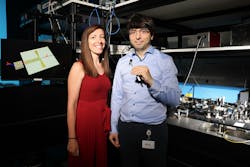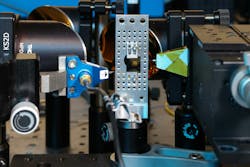Unlock terahertz capabilities within photonic chips
Terahertz (THz) radiation, which spans from 0.1 to 10 THz, occupies a spectral range between electronics and optics. At these frequencies, conventional electronic devices struggle, components hit cut-off limits, and susceptibility to static discharge rises.
Many molecules have strong absorption lines within this range, so THz spectroscopy has been used to identify the fingerprints of various materials for the past few decades. Absorption and the small energy levels that correspond to such frequencies made developing THz sources very challenging. Despite decades of research, most THz devices—whether photonic or electronic—remain bulky, inefficient, or incompatible with established platforms like fiber optics and complementary metal-oxide semiconductor (CMOS) electronics. This makes compact, chip-based THz sources and detectors a sought-after goal.
Our team of researchers from École Polytechnique Fédérale de Lausanne (EPFL) in Switzerland and Harvard University demonstrated a coin-sized lithium niobate chip that can both generate and detect THz pulses by converting them to and from ultrafast optical signals (see Figs. 1 and 2). Our chip was integrated into a telecom fiber system to demonstrate seamless compatibility with commercial fiber technology.
Lithium niobate’s untapped potential
Lithium niobate is already a key platform of the photonics industry. Its crystalline structure exhibits the electro-optic effect: Light passing through the material creates an electrical signal and, conversely, an applied electrical signal changes how light propagates. This property underpins today’s commercial electro-optic modulators used in fiber-optic communications.
Extending this capability into the THz range, however, has long been thought impractical. The obstacle is velocity mismatch. Optical pulses and THz waves travel at very different speeds inside the crystal due to dispersion.
Think of it as akin to a motorbike and a truck driving on the same road—you don’t expect them to travel at the same speed. Our optical and THz pulses share the same medium, but because they’re at vastly different wavelengths they move at very different velocities. Without overlap in time and space, efficient energy conversion between the two becomes nearly impossible.
A road to phase matching
Our team’s key breakthrough is the use of terahertz transmission lines—gold stripes fabricated on the chip to guide the THz waves, while leaving the optical wave undisturbed. By carefully engineering this geometry, we forced the THz pulse to propagate at velocities similar to that of the optical pulse (see Fig. 3). In the road analogy, it’s like putting stones on the truck’s lane so it slows down, while the motorbike is unaffected. Now they travel side by side, see each other, and interact much more efficiently.
This phase-matching method unlocks both efficient THz generation from femtosecond optical pulses and sensitive THz detection on the same chip.
From chip to free space
Many real-world applications require THz signals to radiate into free space. To bridge this gap, our team integrated planar antennas directly onto the lithium niobate chip. These antennas couple the broadband THz pulses out of the chip and into the open, which enables compatibility with imaging, spectroscopy, and wireless communication setups. Borrowing principles from conventional radio-frequency (RF) design, we tuned antenna and transmission line geometries to target specific frequency bands—and it offers the community a new level of control over THz output.
Lithium niobate advantages
To evaluate performance, the team compared our device to commercial photoconductive antennas—the current standard choice for THz generation and detection.
When measuring under the same conditions, we found that our chips already deliver comparable performance. There is plenty of room for optimization, so we believe lithium niobate can soon surpass the state of the art by orders of magnitude.
Lithium niobate brings several intrinsic advantages that make it uniquely suited for THz applications:
-
No bias voltage is required for THz generation—and it enables large-scale integration without complex drive electronics.
-
High-power handling—the material tolerates watt-level optical inputs, with on-chip intensities millions of times higher than those in fiber or free space. This may enable high-power THz applications without room-sized lasers.
-
On-chip modulation—our team demonstrated that THz radiation modulates light, which opens the door to compact terahertz modulators.
Lithium niobate photonic circuits are already fueling applications for 6G communications, quantum technologies, and even optical computing. With this new demonstration, the material’s reach now extends into the terahertz frontier.
Since our method is fully compatible with existing photonic circuits, we hope to enable terahertz operation across the same applications—and open entirely new ones.
Our research was supported by the European Union (MIRAQLS Grant No. 101070700), the Swiss National Science Foundation (PRIMA Grant No. 201547), and the SNSF-NSF Lead Agency program (NSF ECCS-2407727).
FURTHER READING
Y. Lampert et al., Nat. Commun., 16, 7004 (2025); https://doi.org/10.1038/s41467-025-62267-y.
About the Author
Yazan Almahmoud Lampert
Yazan Almahmoud Lampert is a Ph.D. student at École Polytechnique Fédérale de Lausanne (EPFL; Lausanne, Switzerland).


